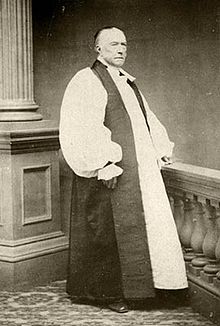John Strachan
|
The Right Reverend John Strachan |
|
|---|---|

John Strachan, Bishop of Toronto
|
|
| Born | April 12, 1778 Aberdeen, Scotland |
| Died | November 1, 1867 (aged 89) Toronto |
| Occupation | Bishop of Toronto |
| Spouse(s) | Ann Wood (m 1808, d. 1865) |
| Parent(s) | John Strachan and Elizabeth Findlayson |
John Strachan (/ˈstrɔːn/; April 12, 1778 – November 1, 1867) was an influential figure in Upper Canada and the first Anglican Bishop of Toronto. He is best known as a political bishop who held many government positions and promoted education from common schools to helping to found the University of Toronto.
Gauvreau says in the 1820s he was "the most eloquent and powerful Upper Canadian exponent of an anti-republican social order based upon the tory principles of hierarchy and subordination in both church and state." Craig characterizes him as "the Canadian arch tory of his era" for his intense conservatism. Craig argues that Strachan "believed in an ordered society, an established church, the prerogative of the crown, and prescriptive rights; he did not believe that the voice of the people was the voice of God."
Dr. Strachan built his home in a large yard bound by Simcoe Street, York Street, and Front Street. It was a two storey building that was the first building in Toronto to use locally manufactured bricks. The gardens and grounds of the property occupied the entire square and became a local Toronto landmark, being given the name "The Bishop's Palace". After Dr. Strachan's death the home was converted into a private hotel called The Palace Boarding House.
Strachan was the youngest of six children born to the overseer of a granite quarry in Aberdeen, Scotland. He graduated from King's College, Aberdeen in 1797. After his father died in an accident in 1794, Strachan tutored students and taught school to finance his own education.
In 1799 he emigrated to Kingston, Upper Canada to tutor the children of other British and United Empire Loyalist immigrants. In Kingston one of his students was John Beverley Robinson, future attorney general of Upper Canada. At the same time, he studied to become ordained.
...
Wikipedia
